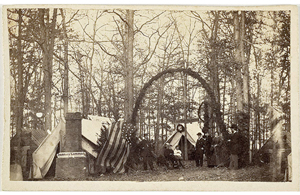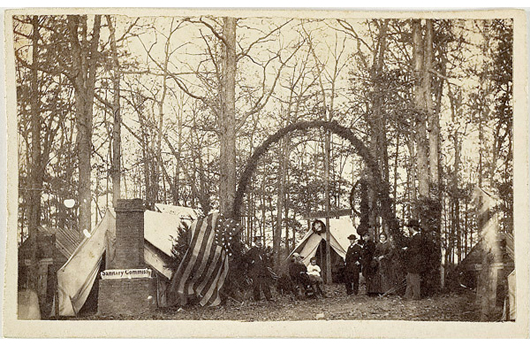
LANCASTER, Pa. (AP) – Re-enactor Richard Ryder has a macabre interest in the Civil War.
It’s one that allows him to recite facts such as, “President Abraham Lincoln’s body was embalmed multiple times as it was taken to various cities for public mourning after he was assassinated.”
Or to boast about having several authentic coffins, autopsy tools and an embalming table, all from the late 1800s.
“I’ve got the world’s most understanding wife,” said Ryder, a self-employed carpenter who lives in Mount Joy, Pa.
When the Manheim Township Historical Society decided it wanted to do something unusual to commemorate the 150th anniversary of the Civil War, Ryder immediately came to the mind of John Snoke, the society’s vice president.
“He’s not your typical re-enactor,” Snoke said.
And so, dressed in period clothing and surrounded by period artifacts – not to mention a mannequin resting in a pine coffin with coins covering its eyes – Ryder spoke to a small crowd Saturday at Manheim Township Library about embalming and undertaking during the Civil War.
“The modern period for embalming in the United States started in 1861, which, obviously, was the start of our Civil War,” he said. “The embalming was experimental at best when it first started, because there were no rules, regulations or guidelines.”
Most soldiers killed in Civil War battles were simply buried in mass graves.
Embalming became popular among wealthy soldiers and officers, as their families sought to have the bodies of their deceased loved ones delivered home from the battlefields for burial.
“In order to do that, you had to preserve them in some fashion,” Ryder said.
Embalmers and undertakers traveled with the Union Army from battle to battle, so they were on hand as soldiers were killed.
The equipment needed for embalming was not readily available in the South, Ryder said. As a result, Confederate armies generally didn’t employ the practice.
It cost soldiers $25 and officers $50 to have their bodies embalmed. (Soldiers typically earned $13 a month in the army.)
They paid for the service in advance and had coupons sewn into their clothing so undertakers sifting through dead bodies would know which ones to pull out.
Undertakers collected the bodies of soldiers and prepared them for burial, while embalming surgeons exchanged a body’s natural fluids with a chemical stew.
Embalmers made their own preservation concoctions, which typically were cocktails of “arsenic, zinc chloride, mercury, salts of aluminum, sugar of lead and creosote,” Ryder said.
“There was a lot of trial and error before they found out what worked best,” Ryder said.
On average, it took about three gallons of embalming fluid to treat a full-grown man.
Ryder sets up his embalming and undertaking camp at Civil War reenactments all over the East Coast.
He started Civil War re-enacting – like most others involved in the hobby – as a soldier with the 50th Pennsylvania Regiment two decades ago.
But the married father of two soon discovered a troublesome rule about re-enacting.
“Women are not allowed in Union camps,” he said. “They could come in and visit, but they couldn’t stay.”
So if he wanted to go to reenactment camps with his wife, son and daughter, he was going to have to find a “civilian impression.”
As a builder, the cabinet-making aspect of undertaking suited Ryder.
“And I have a couple friends who are funeral directors,” he said.
Ryder began researching the role and gathering authentic artifacts to support the position.
Luck, he admits, has been on his side. Like the day he was walking the aisles at Renninger’s Antique Market in Adamstown, Pa., and spotted a wooden and wicker table-like piece of furniture, that was hinged in the middle so the upper half, which had a protruding headrest, could be raised and lowered.
It was advertised for sale as an “antique recliner.”
Technically, the furniture did function like a recliner. But no living person would have sat on it.
“I knew right away it was an embalming table from the late 1800s,” Ryder said. “The couple who sold it to me had no idea that’s what it was until I told them.”
He has a complete embalming surgeon’s kit that someone sold to a friend of Ryder’s who owns an antique shop in Mount Joy.
“My friend called me one day and said, ‘You have to come see what just walked into my store,’” Ryder said. “It was pretty amazing, because this stuff is hard to find.”
Ryder also owns four coffins from the Civil War era, including one lined with zinc, like the coffin Gen. John F. Reynolds arrived home to Lancaster in, after he was shot and killed July 1, 1863, on the first day of the Battle of Gettysburg.
“The only rule my wife has is I can’t keep the coffins in the house,” Ryder said. “If that’s all I have to do to enjoy this hobby, I can live with that.”
___
Online:
http://bit.ly/TF3ViF
___
Information from: Intelligencer Journal/Lancaster New Era, http://lancasteronline.com
Copyright 2012. Associated Press. All rights reserved. This material may not be published, broadcast, rewritten, or redistributed.
AP-WF-09-09-12 1824GMT
ADDITIONAL IMAGE OF NOTE


